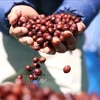The domestic steel industry saw strong growth in consumption in the home market in the first half of this year, according to the Vietnam Steel Association (VSA).
The association reported the purchase of building steel products gained a year-on-year surge of 24.4 percent to reach three million tones in the first half of this year.
Vietnam Steel Corporation (VNSteel) had the largest consumption volume at 696,059 tonnes, accounting for 22.78 percent of the total domestic consumption in the first six months.
The second largest producer was Hoa Phat Steel Company with a volume of 675,710 tonnes, Pomina with 407,426 tonnes and Vinakyoei with 246,262 tonnes.
Meanwhile, the consumption of steel pipes also saw a growth of 34.7 percent in the first six months to 664,583 tonnes against the same period last year, the association said.
The Hoa Phat Steel Company had the largest consumption of steel pipes at 145,300 tonnes, holding 21.85 percent of the total steel tube consumption, followed by Hoa Sen (130,528 tonnes).
Nguyen Van Sua, VSA Vice Chairman, said the growth in the local steel industry supported domestic steel producers in reducing inventories and increasing their production, according to the Cong Thuong (Industry and Trade) newspaper.
To increase consumption, in recent years, companies have promoted exports, but these countries have launched various safeguards, including anti-dumping measures.
Of note, in the first six months the VSA's member companies exported 175,543 tonnes of steel, 5 percent lower than in the same period last year.
Experts said free trade agreements (FTAs) would bring more opportunities and also challenges to local steel producers because the FTAs open more export markets, but cause challenges to local consumption.
Nguyen Van Phong, Deputy General Director of the NS BlueScope Steel Vietnam, said the local galvanised steel industry would have more chances to export galvanised steel products due to advantages from the FTAs, though local steel exporters should be ready to face safeguards in countries participating in the FTAs.
Tran Tuan Duong, General Director of Hoa Phat Group, said the FTAs offer opportunities and challenges, so local steel producers should reduce production costs and selling prices, and improve production management during the integration process into the world economy.
Sua said to gain efficiencies in exports, the producers should study regulations on taxes and schedules of cutting taxes under the FTAs at export markets to avoid lawsuits for dumping Vietnamese steel products in export markets, the Hai Quan (Customs) newspaper reported.
Meanwhile, the producers should improve their competitive abilities, including quality, price and services, to maintain their growth production and business after the FTAs come into effect, Sua said.
To assure continued sustainable development, local steel producers should update technology and equipment, improve corporate management and reduce production costs to reduce selling prices of products, he added. They should also increase knowledge about safeguard measures to avoid commercial lawsuits.
Further, domestic steel industry should develop large steel producers that have financial and technological abilities and an annual capacity at 2-3 million tonnes to compete with import products in the future, he noted.-VNA
The association reported the purchase of building steel products gained a year-on-year surge of 24.4 percent to reach three million tones in the first half of this year.
Vietnam Steel Corporation (VNSteel) had the largest consumption volume at 696,059 tonnes, accounting for 22.78 percent of the total domestic consumption in the first six months.
The second largest producer was Hoa Phat Steel Company with a volume of 675,710 tonnes, Pomina with 407,426 tonnes and Vinakyoei with 246,262 tonnes.
Meanwhile, the consumption of steel pipes also saw a growth of 34.7 percent in the first six months to 664,583 tonnes against the same period last year, the association said.
The Hoa Phat Steel Company had the largest consumption of steel pipes at 145,300 tonnes, holding 21.85 percent of the total steel tube consumption, followed by Hoa Sen (130,528 tonnes).
Nguyen Van Sua, VSA Vice Chairman, said the growth in the local steel industry supported domestic steel producers in reducing inventories and increasing their production, according to the Cong Thuong (Industry and Trade) newspaper.
To increase consumption, in recent years, companies have promoted exports, but these countries have launched various safeguards, including anti-dumping measures.
Of note, in the first six months the VSA's member companies exported 175,543 tonnes of steel, 5 percent lower than in the same period last year.
Experts said free trade agreements (FTAs) would bring more opportunities and also challenges to local steel producers because the FTAs open more export markets, but cause challenges to local consumption.
Nguyen Van Phong, Deputy General Director of the NS BlueScope Steel Vietnam, said the local galvanised steel industry would have more chances to export galvanised steel products due to advantages from the FTAs, though local steel exporters should be ready to face safeguards in countries participating in the FTAs.
Tran Tuan Duong, General Director of Hoa Phat Group, said the FTAs offer opportunities and challenges, so local steel producers should reduce production costs and selling prices, and improve production management during the integration process into the world economy.
Sua said to gain efficiencies in exports, the producers should study regulations on taxes and schedules of cutting taxes under the FTAs at export markets to avoid lawsuits for dumping Vietnamese steel products in export markets, the Hai Quan (Customs) newspaper reported.
Meanwhile, the producers should improve their competitive abilities, including quality, price and services, to maintain their growth production and business after the FTAs come into effect, Sua said.
To assure continued sustainable development, local steel producers should update technology and equipment, improve corporate management and reduce production costs to reduce selling prices of products, he added. They should also increase knowledge about safeguard measures to avoid commercial lawsuits.
Further, domestic steel industry should develop large steel producers that have financial and technological abilities and an annual capacity at 2-3 million tonnes to compete with import products in the future, he noted.-VNA



















